

|
Edward Lowton
Editor |


|
| Home> | Premises management/maintenance | >Lighting | >Shining a light on hazardous environments |
Shining a light on hazardous environments
23 March 2021
Ken Eddleston talks to IP&E about the importance of transportable lighting, especially for those operating in dangerous conditions

HAZARDOUS ENVIRONMENTS present some of the most testing circumstances someone can operate under. Clearly the job needs to get done, no matter what it is, but the risks are high.
What many people underestimate is the impact a good lighting strategy can have on a business’ health and safety record, sustainability credentials and bottom line. Transportable lighting, in particular, delivers a number of benefits not least, it allows workers to operate with precision and accuracy, something that is crucial in any harsh or dangerous environment. Let’s consider these benefits
Staying safe
For senior figures managing an industrial working environment and for those operating within it, workplace safety has to be the number one priority, especially when working in extreme conditions, like at an oil refinery or a chemical plant. Worker safety must come first, even if it has cost implications.
Now, everyone I speak to understands the benefits of health and safety within an organisation, yet many don’t appreciate the benefits a well organised and clear lighting strategy can have, including the addition of transportable lighting, which can be unplugged and moved around.
As an example, imagine you are working in a slippery fuel tank. It is vital that you have sight of your surroundings, but it is not always possible to have fixed ceiling lighting. Having transportable lighting available means that the job can be completed, and the worker doesn’t have to operate in dimly lit conditions.
Given that the majority of industrial tasks are high precision, such as quality checks and reading gauge measurements, it is imperative to give your team the tools they need to perform their role to the best of their ability. Dim lighting leads to errors and could mean the health and safety of the entire site is compromised. Transportable lighting offers a solution.
Of course, transportable lighting must be suited to the environment it’s intended for. This might mean deciding upon lighting that can operate in dusty, flammable or explosive environments. LED lighting is the sensible choice given that it remains cool and operates spark free, ensuring that combustible gases or dust won’t be ignited, protecting the people and equipment that surround it.
Accurate operating
Importantly, transportable lighting also supplies concentrated, targeted lighting, which allows tasks to be carried out with precision. As an example, Chalmit’s Luna LED directs an output up to 5600 lumens, and it is this kind of highly directional, uniform lighting, that provides workers with the necessary conditions to navigate hazardous settings and operate effectively.
Eco boost
Many of the more proactive organisations I speak to also implement transportable lighting to boost their sustainability credentials. Because the light can be so precise and moved around, when it is being used to carry out a single, specific task, the lighting in the rest of the facility does not need to be turned on. This means that companies can be much more deliberate with their lighting without compromising on quality, and they use less electricity in the process. As an additional bonus, working in this way also limits the amount of unwanted light pollution being generated.
Cost savings
Often cost savings are intrinsically linked with a business’ energy efficiency. This is certainly the case for those using transportable lighting in their facilities. By having a light source that can be moved around, the need for lighting in the rest of the plant becomes less. With less lighting comes less electricity being used, equalling large cost savings.
In addition, transportable lighting boasts an impressive lifespan, with some products performing for over 10 years. Given that lighting carries ongoing costs with it, in terms of repairs, maintenance and replacements, using a high performing, long-lasting product makes good business sense. So, by implementing the right lighting strategy that invests in transportable lighting, a business can significantly boost its bottom line.
Ken Eddleston is senior lighting specialist at Chalmit


















